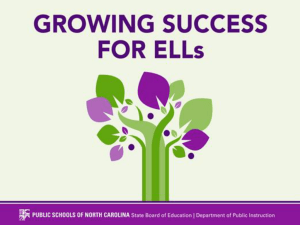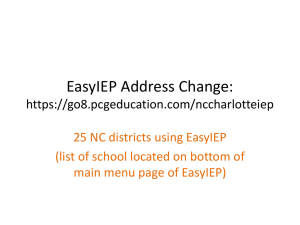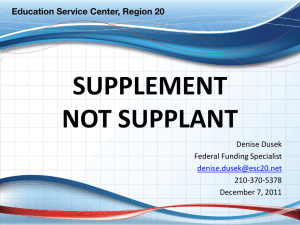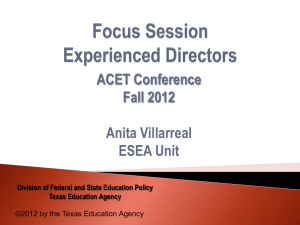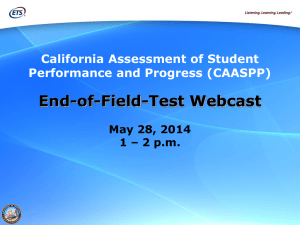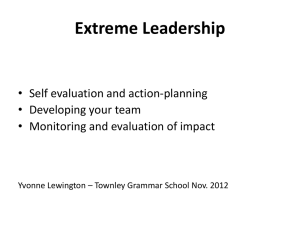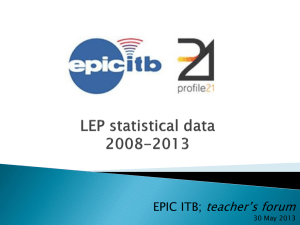funds - ACET
advertisement
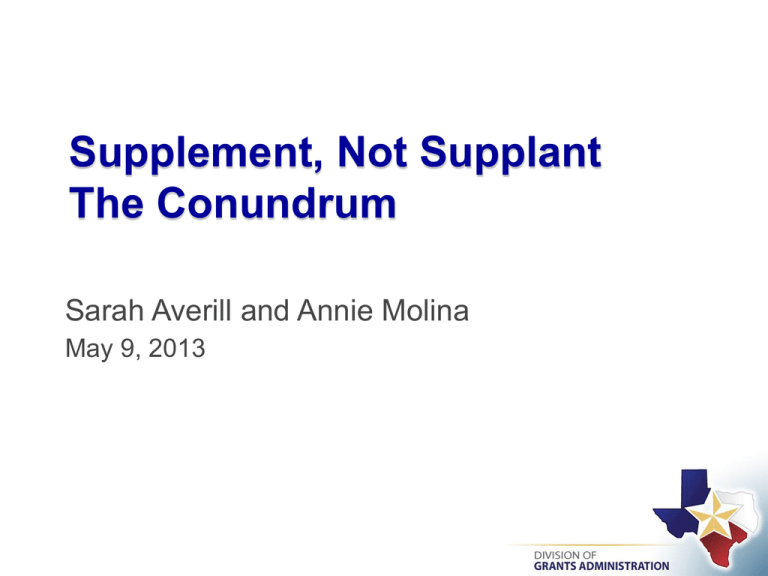
Supplement, Not Supplant The Conundrum Sarah Averill and Annie Molina May 9, 2013 Purpose The purpose of the federal fiscal requirement of supplement, not supplant is to ensure that the level of state and local support for programs remains at least constant and is not replaced by federal funds. 2 Basic Definition Federal funds may not be used to provide services required by state law, State Board of Education rule, or local policy. Funds may not be diverted for other purposes because of the availability of these federal funds. 3 Bare Bones Definition Supplement—to add to, to enhance, to expand, to increase, to extend. Supplant—to take the place of, to replace. 4 Ensuring S/NS LEA assures this in the Program-Specific provisions and assurances for the respective grant. 5 6 Specific, Consistent Definition No single definition in the Elementary and Secondary Education Act (ESEA). More than 30 S/NS provisions in all ten titles. S/NS language will be in the actual authorizing program statute or in an amendment to the statute. 7 Supplement, Not Supplant Statutory Requirements 8 Title I, Part A A local education agency (LEA) shall use Title I, Part A funds only to supplement the amount of funds that would, in the absence of Title I, Part A funds, be made available from non-federal sources for the education of students participating in Title I, Part A programs, and, in no case may Title I, Part A funds be used to supplant those non-federal funds. [P.L. 107-110, Section 1120A(b)] 9 Title I, Part A Schoolwide vs. Targeted Assistance S/NS Requirements Schoolwide Programs—Title I, Part A funds must be supplemental to the amount of funds available from non-federal sources for the campus including funds needed to provide services that are required by law for children with disabilities and children with limited English proficiency. Targeted Assistance Programs—Title I, Part A funds and services must be supplemental. 10 Title I, Part C – Migrant Title I, Part C funds first shall be used to meet the identified needs of migratory children that result from their migratory lifestyle, and to permit these children to participate effectively in school. Funds shall be used to address the needs of migratory children that are not addressed by services available from other federal or nonfederal programs. [P.L. 107-110, Section 1306(b)(1&2)] 11 Title I, Part D A Title I, Part D program that supplements the number of hours of instruction students receive from state and local sources shall be considered to comply with the supplement, not supplant requirement of section 1120A (as applied in this part) without regard to the subject areas in which instruction is given during those hours. [P.L. 107-110, Section 1415(b)] 12 Title II, Part A An LEA shall use Title II, Part A funds only to supplement, not supplant, non-federal funds that would otherwise be used for activities authorized under Title II, Part A. [P.L. 107-110, Section 2123(b)] 13 Title III, Part A Title III, Part A funds shall be used so as to supplement the level of federal, state, and local public funds that, in the absence of such availability, would have been expended for programs for limited English proficient children and immigrant children and youth and in no case to supplant such Federal, State, and local public funds. [P.L. 107-110, Section 3115(g)] 14 Title IV – 21st Century Title IV, 21st CCLC funds will be used to supplement, and not supplant, other federal, state, and local public funds expended to provide programs and activities authorized under this part and other similar programs. [P.L. 107-110, Section 4203(a)] 15 Title VI, Part A, Subpart 2— Funding Transferability Funds that are redirected through Funding Transferability are subject to the supplement, not supplant requirement as it applies to the fund source to which the funds are redirected. 16 Title VI, Part B—Section 6211 REAP-Flex Funds that are redirected through REAP are subject to the supplement, not supplant requirement as it applies to the fund source to which the funds are redirected. [P.L. 107-110, Section 6232] 17 Summary… State and Local Funds Title I, Part A Title I, Part D Title II, Part A 21st Century Federal, State, and Local Funds Migrant Title III, Part A Any funds redirected to one of these programs under FT or REAP-Flex Any funds redirected to one of these programs under FT or REAP-Flex 18 Example… Title III, Part A Title I, Part A funds for LEP students State and Local funds for LEP students LEA Services to Limited English Proficient Students 19 Enhancing, Expanding, or Extending Required Activities 20 Enhancing, Expanding, or Extending Required Activities If federal funds are used to enhance or expand a state mandate, SBOE rule, or local board policy, then the federal supplementary activities must be separately identified and clearly distinguishable from those activities identified as necessary for implementing the state mandate, SBOE rule, or local board policy as outlined in the implementation plan. 21 Enhancing, Expanding, or Extending Required Activities The LEA must be able to document a clear plan for each – one plan for meeting the mandated requirement, another plan for providing supplementary activities from federal funds in addition to the mandated requirement. 22 Documenting S/NS Recipients of federal funds must maintain documentation which clearly demonstrates the supplementary nature of the funds and activities. In most cases, it is both the funding and the activities that must be supplemented. (other than Title I) Then, the auditors test S/NS. 23 Am I Supplanting? Ask yourself, your team, your business office…. If I didn’t have federal funds available to conduct this activity/service, would I still conduct it with state or local (or other federal) funds anyway? 24 Penalties for Supplanting All federal funds involved in a supplanting situation would most likely have to be returned to the federal government. Since audits are usually conducted after the grant period has ended, there is often no other alternative corrective action available other than the LEA returning the funds. 25 Auditing Supplement, Not Supplant “3 Tests + 1” 26 Three Presumptions of Supplanting Pursuant to guidance from the U.S. Office of Management and Budget (OMB), the U.S. Department of Education (USDE) auditors presume that supplanting has occurred in three general situations. 27 Three Presumptions of Supplanting Test 1: Mandated Activity 28 Test 1: Did the LEA provide services that the LEA is required to make available under state law, SBOE rule, Commissioner’s rule, or local policy? If: The LEA used federal funds to pay for a required mandate or to meet local policy. 29 Test 1: Did the LEA provide services that the LEA is required to make available under state law, SBOE rule, Commissioner’s rule, or local policy? Then: Written documentation must be maintained How are other funds expended? Can the LEA prove it would not have implemented the other federal, state, or local requirements? 30 Three Presumptions of Supplanting Test 1: Test 2: Mandated Prior Year Activity Funding 31 Test 2: Did the LEA provide services that the LEA provided in a prior school year with non-federal funds? IF: State or local funds which previously funded activities are diverted to another purpose because federal funds are now available to fund those activities… 32 Test 2: Did the LEA provide services that the LEA provided in a prior school year with non-federal funds? Then: Written documentation must be maintained Documentation must show that the original source of funding is no longer available and the service or activity would not have been continued in the next school year. 33 Test 2: Did the LEA provide services that the LEA provided in a prior school year with non-federal funds? Furthermore: This situation must be documented at the time the decisions to not continue the service or activity is made. This situation cannot be documented after-the-fact. The LEA cannot plan in advance for a reduction of funds. 34 Three Presumptions of Supplanting Test 1: Mandated Activity Test 2: Test 3: Prior Year Campus to Funding Campus 35 Test 3: Did the LEA provide services to students participating in a federal program that the LEA provides to non-federal (i.e., Title I) students or students at non-federal (i.e., Title I) schools with non-federal funds. Rebuttal: The rebuttal to this presumption is often the “Exclusion for Title I-like programs”. Otherwise, not usually rebuttable. 36 “Exclusion for Title I-like Programs” For the purposes of compliance with the supplement, not supplant (1120A(b)) and comparability (1120A(c)) LEA may exclude supplemental state or local funds expended in any school attendance area or school for programs that meet the intent and purpose of Title I, Part A. 37 Three Presumptions of Supplanting Test 1: Mandated Activity Test 2: Prior Year Funding Test 3: Campus to Campus Is it Allowable? 38 The 4th audit test….Is it Allowable? Regardless of documentation and rebuttal of the supplant assumptions, the activity must be an allowable expenditure under the program. In any case, the independent auditor may still consider the expense a supplant. 39 Maintaining supplemental in times of diminishing LEA budgets…. 40 Diminished Budgets and S/NS LEA may be able demonstrate that it is supplementing where there is acceptable documentation of a diminished budget. Must be able to prove (in the actual budget) that fewer state or local funds are available in the current school year than were available in the previous school year. Must be carefully documented. But, remember… 41 Test 2: Did the LEA provide services that the LEA provided in a prior school year with non-federal funds? The LEA cannot plan in advance for a reduction of funds. 42 Supplemental or A Supplant? You Decide… 43 Scenario 1 A teacher who is 100% locally and state-funded becomes the newly appointed program manager for a federal grant. The budget page in the grant application states that 100% of this position will be devoted to the federal grant program. Another teacher is hired to take over the teaching duties. 44 Scenario 1 A teacher who is 100% locally and state-funded becomes the newly appointed program manager for a federal grant. The budget page in the grant application states that 100% of this position will be devoted to the federal grant program. Another teacher is hired to take over the teaching duties. 45 Scenario 2 A grant allows professional development to be paid out of the funds. The district wants to pay for already scheduled and/or budgeted professional development and/or inservice with these new grant funds. 46 Scenario 2 A grant allows professional development to be paid out of the funds. The district wants to pay for already scheduled and/or budgeted professional development and/or inservice with these new grant funds. 47 Scenario 3 A campus has a full-time assistant principal. The district applying for a grant project wants to have the assistant principal spend ½ day serving as assistant principal, and ½ day managing this new grant. They would charge ½ the salary to state/local funds and ½ the salary to the grant. 48 Scenario 3 A campus has a full-time assistant principal. The district applying for a grant project wants to have the assistant principal spend ½ day serving as assistant principal, and ½ day managing this new grant. They would charge ½ the salary to state/local funds and ½ the salary to the grant. 49 Scenario 4 A district wants to pay consultants for activities that district personnel are already performing under the grant. 50 Scenario 4 A district wants to pay consultants for activities that district personnel are already performing under the grant. 51 Scenario 5 As a course of business, the district has consistently used local or state funds to always pay for the substitutes. The district has recently been awarded a federal grant where they have requested funds to pay for substitutes while teachers attend professional development. The district will now use the federal funds to pay for substitutes while the teachers go to their training. 52 Scenario 5 As a course of business, the district has consistently used local or state funds to always pay for the substitutes. The district has recently been awarded a federal grant where they have requested funds to pay for substitutes while teachers attend professional development. The district will now use the federal funds to pay for substitutes while the teachers go to their training. 53 Scenario 6 A district that receives grant funding to provide staff training to school districts charges a registration fee for staff to participate in specific training sessions. Each participant receives a complete training manual and set of materials to use in their classroom. The fees collected are used to offset the printing and binding cost of the materials provided during the training. 54 Scenario 6 A district that receives grant funding to provide staff training to school districts charges a registration fee for staff to participate in specific training sessions. Each participant receives a complete training manual and set of materials to use in their classroom. The fees collected are used to offset the printing and binding cost of the materials provided during the training. 55 Scenario 7 A grantee uses various sources of federal funding to provide a supplementary program for children not meeting standards. Some of the federal funding sources are expiring as other new grant funding is beginning. The program uses the new federal grant funds to replace the expiring funding sources to continue this program. 56 Scenario 7 A grantee uses various sources of federal funding to provide a supplementary program for children not meeting standards. Some of the federal funding sources are expiring as other new grant funding is beginning. The program uses the new federal grant funds to replace the expiring funding sources to continue this program. 57 A supplement not supplant handbook was developed by the Chief Grants Administrator in conjunction with the Division of Federal Fiscal Monitoring. The handbook will be available by approximately May 30, 2013 at the following website: http://www.tea.state.tx.us/index2.aspx?id=214748 7920&menu_id=951 58 Division of Grants Administration Texas Education Agency (512) 463-8525 grants@tea.state.tx.us 59 © 2013 by the Texas Education Agency Copyright © Notice. The materials are copyrighted © and trademarked ™ as the property of the Texas Education Agency (TEA) and may not be reproduced without the express written permission of TEA, except under the following conditions: 1. Texas public school districts, charter schools, and Education Service Centers may reproduce and use copies of the Materials and Related Materials for the districts’ and schools’ educational use without obtaining permission from TEA. 2. Residents of the state of Texas may reproduce and use copies of the Materials and Related Materials for individual personal use only without obtaining written permission of TEA. 3. Any portion reproduced must be reproduced in its entirety and remain unedited, unaltered and unchanged in any way. 4. No monetary charge can be made for the reproduced materials or any document containing them; however, a reasonable charge to cover only the cost of reproduction and distribution may be charged. Private entities or persons located in Texas that are not Texas public school districts, Texas Education Service Centers, or Texas charter schools or any entity, whether public or private, educational or non-educational, located outside the state of Texas MUST obtain written approval from TEA and will be required to enter into a license agreement that may involve the payment of a licensing fee or a royalty. For information contact: Office of Copyrights, Trademarks, License Agreements, and Royalties, Texas Education Agency, 1701 N. Congress Ave., Austin, TX 78701-1494; email: copyrights@tea.state.tx.us. 60
